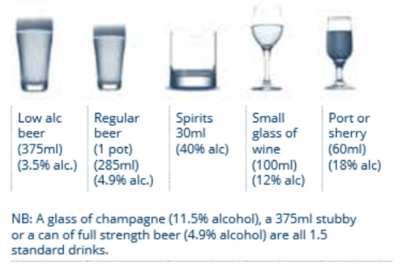We all enjoy a few relaxing bevvies with mates. But drink-driving can come with a much higher cost than the bar tab when it’s your shout. That’s why it pays to understand the risks of drink-driving.
“One more for the road” is something we don’t hear much anymore. Conversations are more likely to be around who’s the DD – the designated driver that’s raised a hand to stick to light beers or soft drinks so everyone can get home without worries about drink-driving.
In the 25-plus years since blood alcohol concentration limits were introduced in Australia1, trauma from fatal car crashes involving alcohol has plunged from 40% of all fatalities to about 15% in states like NSW2.
That’s good news. But even today, ‘one too many’ can have serious consequences that go beyond a ‘please explain’ from the coppers.
How does alcohol impact your driving?
According to the Accident Research Centre at Monash University3, alcohol is a depressant that affects us both physically and mentally. It can impact our judgement, memory and reaction times – all of which are essentials when it comes to driving.
More specifically, alcohol affects drivers in four main ways:
- It slows reaction times – something that’s critical in an emergency situation
- It dulls our thought processes, making it harder to multi-task – a must-have skill for safe driving
- It reduces our attention span, so we may not be as aware of other vehicles, drivers or even pedestrians
- It causes blurred vision and reduced hearing, which means we don’t identify driving hazards as well as we normally do.
On the flipside, alcohol can boost our confidence. A few too many drinks, and it’s easy to assume we’re ‘good to go’. That’s why it pays to know the true story around how much is too much before clinking glasses for the first round.
Understanding the law – What is the legal limit?
The legal limits around how much alcohol you can drink – and legally get behind the wheel of a car, are based on ‘Blood Alcohol Concentration’ (BAC). This measures how much alcohol is in your system in terms of grams of alcohol per 100 millilitres of blood4.
In Australia, if you have a full licence (sometimes called a ‘black’ licence), it’s an offence to drive if your BAC is 0.05 or above5. That means there’s at least 0.05 grams (50 milligrams) of alcohol in every 100 millilitres of your blood.
Learner drivers and P-platers must have a 0% BAC. In other words, until you get a full licence, steer clear from alcohol altogether if you’re planning to drive.
How much is a standard drink?
For full licence holders, it is important to understand how alcohol can affect your body and BAC level. A standard drink is said to contain 10 grams of alcohol6.
Of course, not all drinks are created equal. Some have far higher concentrations of alcohol than others. The diagram below shows what a standard drink looks like depending on your choice at the bar.
|
What one standard drink looks like |
 |
|
Source: National Road Safety Partnership Program7 |
Bear in mind, these guidelines are just that – rules of thumb only. How much alcohol is in your blood can also be impacted by your body mass, how much food you’ve eaten and your overall health8.
The consequences of drink-driving?
Few things can ruin a good night out faster than being pulled over for a random breath test and blowing a positive reading. Exactly what happens next depends on how high your BAC is, your driving record and where you get caught – the rules can vary between states and territories.
In general, if you test positive at a roadside breath test, you’ll be hauled off to the local police station for further testing (leaving your car behind). If that test shows your BAC is still over the legal limit, it’s worth having your lawyer on speed dial. You may be asked to appear in court and be charged with a drink-driving offence.
In New South Wales, which introduced stricter drink-driving penalties in 2019, a positive reading can mean immediate suspension of your driver’s licence plus a fine of $5879. No questions asked. This applies even if you had a low range BAC.
Cop a high range reading – or if you’re a repeat offender, and you may have to install an interlock device in your car, which immobilises your car’s ignition if alcohol is detected in your breath.
The upshot, is that no matter where in Australia you are, you could face a solid fine, score a criminal conviction and find yourself in the long queue for public transport10. Worst case scenario, you could end up doing time11.
In reality, these are not the worst things that could happen. With a few drinks under your belt, drink-driving could see you involved in a serious accident – one that costs lives. Potentially your own.
<H2>How do you report a drunk driver?</H2>
Plenty of us have had those “What is that driver doing?” moments when a fellow motorist weaves a wobbly path through the traffic.
It can be distracting – and downright worrying, especially if it looks as though the driver’s had a few too many. The thing is, the police get no joy out of picking up the pieces after a car crash. They would much rather prevent them. And there is action you can take to report a drunk driver.
If you’re on the road, here are some steps you might want to take12:
- If available, use a passenger to record the time of the incident and the registration of the other driver’s vehicle
- If possible, keep dashcam vision of the incident and provide it to Crime Stoppers or the police
- If it’s an emergency – where there is a threat to life or someone’s safety, call Triple Zero (000) through a passenger, a hands-free device, or pull over somewhere safe
- If it’s not an emergency, contact Crime Stoppers on 1800 333 000. Thisnumber applies across Australia.
<H2>Does drink-driving impact your car insurance costs?</H2>
If you’ve been caught DUI, your insurer may hike your premiums by up to 50%, or ask you to agree to a far bigger excess if you need to make a claim.
The only way to know for sure is to phone your insurer or comb through the fine print of your car cover policy. It could mean having to shop around to find an insurer who will take you on without too much hurt in the hip pocket.
<H2>The real costs of drink-driving</H2>
It’s pretty clear that driving after a few drinks can come at a heavy price. But there can be additional hidden costs to consider.
<H3>Cost of fixing car</H3>
If you get behind the wheel of your car, and you’re over the legal limit – remember that’s 0.05 if you’re on a full licence, or 0 if you’re an L- or P-plater, your car insurance won’t cover you for any resulting claims13. That can leave you seriously out of pocket if you have a fender bender. According to comparison site Finder14, your insurer may still refuse a claim even if you’re under the legal limit, but alcohol was found to affect your judgement.
Fortunately, a Nimble Personal Loan can come to your financial rescue, helping you get your set of wheels out of the panel beaters and back on the road.
<H3>Risk and impact on human life</H3>
No one wants to be a statistic, right? Especially not the sort of number that drink-driving can lead to. For all the advances made in reducing the impact of drink-driving on road safety, it’s still the number one contributing factor in around one third of fatal crashes in Australia15.
Looked at another way, over 1 in 4 drivers and riders killed on Australian roads have a BAC exceeding the legal limit16. It’s a sobering thought.
<H3>Damaging your own health</H3>
Apart from the risks involved in getting behind the wheel after a few drinks, excessive alcohol consumption does nothing for your health. Over time it can lead to increased risk of diabetes, a whole variety of cancers from stomach and bowel cancer through to liver cancer, fertility issues and even brain damage. Hardly the sorts of things most of us look forward to.
The bottom line? If wanting to enjoy a drink or two, work out a designated driver or have a Plan B to get home safely if it looks like being a big night. But drink-driving? Nah, it’s definitely not worth it.
Disclaimer: Please note this content is provided as general information only and does not take into account your objectives, financial situations or needs. For advice tailored to your financial situation, it is advised that you seek guidance from an accountant or financial advisor. The above post refers to application software (“App, Apps”) that is not affiliated or associated with Nimble. We do not have any control or responsibility over the content of the Apps. Use of the Apps may be subject to further terms and conditions imposed by the App provider, the owner of the mobile operating system and/or other related parties. The above links belong to a variety of websites and not Nimble, so clicking on, and using them, will take you away from Nimble’s website meaning we’ve got no control or responsibility over the content. Nimble does not endorse and is not affiliated or associated in any way whatsoever to the businesses named in this blog post. The information contained in this article is correct at the date of publication.
- https://www.nrspp.org.au/resources/fact-sheet-drink-driving/
- https://roadsafety.transport.nsw.gov.au/stayingsafe/alcoholdrugs/drinkdriving/rbt/index.html
- https://www.nrspp.org.au/resources/fact-sheet-drink-driving/
- https://roadsafety.transport.nsw.gov.au/stayingsafe/alcoholdrugs/drinkdriving/bac/index.html
- https://www.police.wa.gov.au/Traffic/Offences/Drink-and-Drug-Driving
- https://www.nrspp.org.au/resources/fact-sheet-drink-driving/
- https://www.nrspp.org.au/resources/fact-sheet-drink-driving/
- https://nt.gov.au/driving/safety/alcohol-drugs-and-driving
- https://roadsafety.transport.nsw.gov.au/stayingsafe/alcoholdrugs/drinkdriving/reforms/index.html
- https://astorlegal.com.au/is-drink-driving-really-a-criminal-offence/
- https://www.sydneycriminallawyers.com.au/blog/what-should-you-do-if-youre-caught-drink-driving/
- https://nsw.crimestoppers.com.au/road-users-called-on-to-report-drink-drug-affected-dangerous-and-distracted-drivers-as-part-of-new-campaign/
- https://www.finder.com.au/car-insurance-for-drink-drivers
- https://www.finder.com.au/car-insurance-for-drink-drivers
- https://www.nrspp.org.au/resources/fact-sheet-drink-driving/
- https://www.nrspp.org.au/resources/fact-sheet-drink-driving/
Popular Posts

12 Ways to Make Money Without Having a Traditional Job
August 19, 2019

The complete home maintenance budget guide and how a home renovation loan could help
April 30, 2019

Our Before-and-After Photo Competition
December 14, 2021

Budget Planning for Students: The University Student Budgeting Guide
June 5, 2019